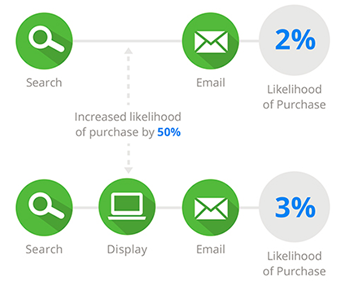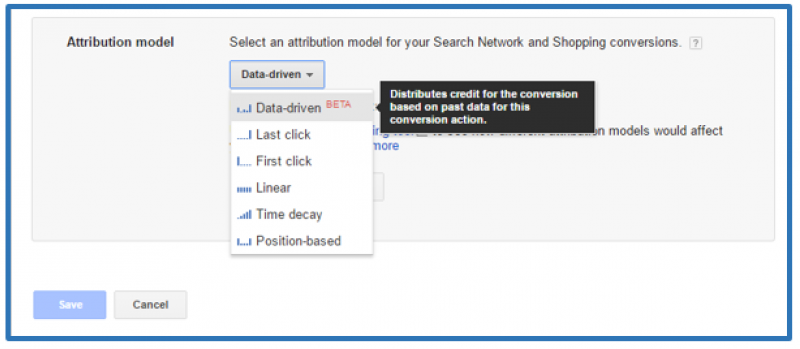Data-Driven Attribution Models Across Google Platforms
07 Mar 2017

If you have ever managed any marketing, the chances are you are aware of the limitations of reporting on a last click basis. But what model should you choose instead? Should you go for one of the other standard, rules-based models, or set up a custom one? What would you include in a custom model and how would you weigh the different channels and interactions? These are all difficult questions that require in-depth attribution analysis of your channels to answer.
Now you have the chance to leave the model selection up to Google! Data-Driven Attribution (DDA) models are available across multiple platforms within Google's marketing stack: Google Analytics 360, DoubleClick and AdWords.
Below is a brief explanation on how DDA models work and how they differ across the three platforms. Ultimately, Google Analytics 360 provides the best of both worlds – read on to find out why.
How Data-Driven Driven Attribution Models Work
Data Driven Attribution Models (DDAMs) consider many factors in a customer journey, including path length, order of exposure and creatives; just like an advanced custom model would. However, that doesn't even scratch the surface of what they are capable of.
DDAMs process the path of every customer, whether they ended with a conversion or not. It compares the conversion rates of similar paths, then credits the difference in conversion rate to the missing channels, easily explained in the image below:

In the above, Google doesn't simply give 50% of the credit to Display, but it uses the Shapley value for cooperative game theory to calculate the exact credit it should receive.
What makes DDAMs even more powerful is that they are dynamically updated fortnightly, to cope with behavioural changes. This means that in theory the model is able to tackle seasonal effects, something that rules-based, static models (even custom models) can't do. Furthermore, DDAMs can programmatically determine the ideal lookback window for your data. One frustration here is that this lookback window is not revealed in any of the platforms, hence it won’t inform you on your business' repurchasing cycle, for example.
In order to carry out these complex calculations, DDAMs require a minimum number of sessions and conversions, which are summarised in the table below.
AdWords
In two ways DDAMs are the most integrated with the AdWords interface. Firstly, AdWords introduced the option to choose the attribution model for each conversion type at the end of May, including DDA if the limits are met. This allows all reports to report conversion figures that had been calculated programmatically by the method described above.

Secondly, AdWords has the capability of linking DDAMs to its auto-bidding system (for any bid type). This means that you can take advantage of Google's machine learning for both reporting and optimisation. AdWords also uses all interactions in the customer journey to determine the best model for your data.
However, AdWords' attribution had always been limited by the fact that the only channel it can identify is Paid Search. Hence you'll be able to optimise your Paid Search campaigns and keywords but it isn't possible to optimise across your different online marketing channels in AdWords.
Lastly, the DDA model in AdWords is algorithmic only, so you can't add any additional rules or change the lookback window manually.
DoubleClick
DoubleClick has visibility over Display, Paid Search, Click Trackers and Natural Search. It therefore has a more holistic view of your online marketing channels.
Unlike in AdWords where you could choose the attribution model for each conversion type, in DoubleClick you can only have one DDAM per Floodlight Configuration. Furthermore you need to select the conversion types (Floodlight Activities in DoubleClick) and the channel grouping for the DDAM during setup. As a result, you will only have one DDAM that works for the pre-selected conversion types and one channel grouping per Floodlight Configuration.
It’s important to note that you can define the lookback window manually. This can be useful, for instance, if you know your customers follow a strict repurchasing cycle, although the DDAM should be calculating this.
On the other hand, DoubleClick only takes the last four interactions before a conversion into account to determine the model. DDA is only available in the Attribution Modelling Tool of DCM and not every report. However it can also be used for auto-bidding in DoubleClick for Search and AdWords.
Google Analytics
GA provides the most holistic view of your marketing since it has visibility over all of your online marketing channels. This means that you can compare and optimise all of your online channels.
Unlike DoubleClick, in GA you don't have to commit to a set of pre-selected conversion types (Goals in GA) or a single channel grouping. You don't need to set these at the set up process, but you can select and toggle between them during analysis. You are also not limited to a single DDA model; you can have multiple DDAMs in a view.
Just like DoubleClick, you can set your lookback window manually in GA and also define custom rules, similar to the way you would set up a traditional, rules-based custom model. You therefore have the best of both worlds by combining the machine learning aspect of DDA with your personal experience of the business.#
DDAMs are only available in Google Analytics 360, in the Model Comparison Tool, and as with DoubleClick, only take the last four interactions before a conversion into consideration.
Data Driven Attribution Models have the potential to revolutionise how we value our marketing channels, thus how we optimise them. Given the relative infancy of DDAMs, we still face limitations across all three platforms, but our close relationship with Google ensures that we stay at the forefront of new developments, so stay tuned for further updates.
To read this blog written by Nam-Anh Tran on the Periscopix website, please click here.

Please login to comment.
Comments